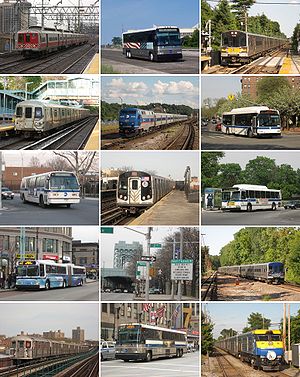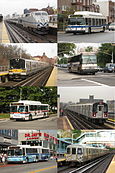- Metropolitan Transportation Authority (New York)
-
Metropolitan Transportation Authority
of the State of New York

The Metropolitan Transportation Authority (New York) (MTA) provides local and express bus, subway, and regional rail service in Greater New York, and operates multiple toll bridges and tunnels in New York City.Info Locale New York City
Long Island
Lower Hudson Valley
Coastal ConnecticutTransit type Commuter rail, Local and Express bus, Subway, Bus rapid transit Number of lines 16 (commuter rail)
24 (subway)
338 (bus)
2 (BRT)Daily ridership 11,574,566 (weekday; all modes)[1][2][3][4]
(2007 figures)Chief executive Andrew M. Saul (Acting chairman and chief executive officer)[5] Headquarters 347 Madison Avenue, New York, NY 10017 Operation Began operation 1965 Operator(s) Number of vehicles 2,290 commuter rail cars[1][6]
6,399 subway/SIR cars[6]
5,958 buses[2][2][7]The Metropolitan Transportation Authority of the State of New York (MTA) is a public benefit corporation responsible for public transportation in the U.S. state of New York, serving 12 counties in southeastern New York, along with two counties in southwestern Connecticut under contract to the Connecticut Department of Transportation, carrying over 11 million passengers on an average weekday systemwide, and over 800,000 vehicles on its seven toll bridges and two tunnels per weekday.[8]
Contents
History
Chartered by the New York State Legislature in 1965 as the Metropolitan Commuter Transportation Authority (MCTA) it initially was created to purchase and operate the bankrupt Long Island Rail Road. The MCTA changed its name to the Metropolitan Transportation Authority (MTA) in 1968 when it took over operations of the New York City Transit Authority (NYCTA) and Triborough Bridge and Tunnel Authority (TBTA), now MTA New York City Transit (NYCT) and MTA Bridges and Tunnels (B&T) respectively. Between 1971 and 1972 it assumed operation of Penn Central's New Haven, Hudson and Harlem commuter rail lines, which were given over to Conrail in 1976 and re-acquired in 1982 and operated as Metro-North Commuter Railroad.
Responsibilities and service area
The MTA has the responsibility for developing and implementing a unified mass transportation policy for The New York metropolitan area, including all five boroughs of New York City, the suburban counties of Dutchess, Nassau, Orange, Putnam, Rockland, Suffolk and Westchester, all of which together are the "Metropolitan Commuter Transportation District (MCTD)". Joseph Lhota has been nominated to replace Jay Walder as Chairman and CEO of the MTA on October 21, 2011 by Governor Cuomo. Nuria Fernandez has also been nominated as Chief Operating Officer. [9]
The MTA is the largest public transportation provider in the Western Hemisphere. Its agencies serve 14.6 million people spread over 5,000 square miles (13,000 km²) from New York City through southeastern New York State (including Long Island and the lower Hudson Valley), and Connecticut. MTA agencies now move more than 2.6 billion rail and bus customers a year and employ approximately 70,000 workers.
Related entities
MTA carries out these planning and other responsibilities both directly and through its subsidiaries and affiliates, and provides oversight to these subordinate agencies, known collectively as The Related Entities.[10] The Related Entities represent a number of previously existing agencies which have come under the MTA umbrella. In turn, these previously existing agencies were (with the exception of MTA Bridges and Tunnels and MTA Capital Construction) successors to the property of private companies that provided substantially the same services.
Each of these Related Entities has a popular name and in some cases, a former, legal name. The popular names were part of an overall corporate identification effort in 1994 to eliminate the confusion over the affiliations of the various "authorities" that were part of the MTA.[11] Legal names have since only been used for legal documents, such as contracts, and have not been used publicly; however, since the mid-2000s, the popular name has also been used for legal documents related to contract procurements where the legal name was used heretofore. Both are listed below.
Subsidiary agencies
- Long Island Rail Road (LIRR)
(legal name - no longer used publicly: The Long Island Rail Road Company) - Metro-North Railroad (MNR)
(legal name - no longer used publicly: Metro-North Commuter Railroad Company) - Staten Island Railway (SIR)
(legal name - no longer used publicly: Staten Island Rapid Transit Operating Authority) - MTA Bridges and Tunnels (MTA B&T)
(legal name - no longer publicly used: Triborough Bridge and Tunnel Authority) - MTA Capital Construction (MTACC)
(legal name used) - MTA Regional Bus Operations (legal name - not publicly used; but rather trading as):
- Long Island Bus (or LI Bus)
(former legal name - Metropolitan Suburban Bus Authority) - MTA Bus
(legal name - sometimes used publicly: MTA Bus Company) - MTA New York City Bus
(former legal name - New York City Transit Department of Buses)- Select Bus Service
(the Bus Rapid Transit brand for MTA New York City Bus)
- Select Bus Service
- Long Island Bus (or LI Bus)
Affiliate agencies
- MTA New York City Transit (NYCT)
(legal name - no longer publicly used: New York City Transit Authority and its subsidiary, the Manhattan and Bronx Surface Transit Operating Authority) (MaBSTOA). NOTE: The Bus division is now managed under Regional Bus.
Governance
The MTA is governed by a 17-member board representing the 5 boroughs of New York City and each of the counties in its service area.
Members are nominated by the Governor of New York, with four recommended by New York City’s mayor, and one each by the county executives of Nassau, Suffolk and Westchester counties. Each of these members has one vote.
The executives of the northern counties of Dutchess, Orange, Rockland, and Putnam also nominate a member each, but these members cast one collective vote. The Board also has six rotating nonvoting seats held by representatives of organized labor and the Permanent Citizens Advisory Committee, which serves as a voice for users of MTA transit and commuter facilities.
All board members are confirmed by the New York State Senate.
Budget Issues
The budget deficit of the MTA is a growing crisis for the organization as well as New York city and state residents and legislature. The MTA currently holds $31 billion in debt and it also suffers from a $900 million gap in its operating budget for 2011 [12].
Causes
The MTA has consistently run on a deficit, but increased spending in 2000-2004 coupled with the economic downturn has led to a severe increase in the financial burden that the MTA bears. The current budget problems stems from multiple sources. The MTA cannot be supported solely by rider fares and road tolls. In the preliminary 2011 budget, MTA forecasted operating revenue totaled at $6.5 billion, amount to only 50% of the $13 billion operating expenses [13]. Therefore the MTA must rely on other sources of funding to remain operational. Revenue collected from real estate taxes for transportation purposes has helped to contain the deficit. However, due to the weak economy and unstable real estate market, money from these taxes has severely decreased; in 2010, tax revenue fell at least 20% short of the projected value [14]. Beyond this, steadily reducing support from city and state governments has led to borrowing money by issuing bonds, which has contributed heavily to the debt that is present today [15].
Results
This budget deficit has resulted in various problems, mainly concentrated in New York City. New York City Subway fares have been increased three times since 2008, with the most recent occurring December 30, 2010, raising single-ride fares from $2.25 to $2.50 and the monthly MetroCard fare from $89 to $104 [16]. Each fare raise has been met with increasing resistance by MTA customers, and many are beginning to find the fare increases prohibitive. 2010 also saw heavy service cuts for many MTA subsidiaries (see [8]). Fewer trains spaced farther between has resulted in heavy overcrowding beyond normal rush hours [17]. leading to frustration for many subway and bus riders. MTA employees have also suffered due to the budget issues. By mid-July of 2010 MTA layoffs had reached over 1000, and many of those affected were low-level employees who made less than $55,000 annually [18].
See also
External links
 External videos
External videos
Ten Years Later: MTA Reflects on 9/11, Metropolitan Transportation Authority; September 7, 2011; 4:21 YouTube video clip - NY Metropolitan Transportation Authority home page
- Permanent Citizens Advisory Committee to the MTA
- NYPIRG Straphangers' Campaign, a transit rider's advocacy group
- MTA's YouTube Video Information Channel
- The Metropolitan Transportation Authority (MTA) Facebook General Information Web Link
- The MTA's Metro-North Railroad Facebook Information Web Link
- The MTA's Bridges And Tunnels Facebook Information Web Link
- The MTA's Long Island Rail Road (LIRR) Facebook Information Web Link
- The MTA's New York City Transit (NYCT) Facebook Information Web Link
- The MTA's New York City Transit Museum (Brooklyn) Facebook Information Web Link
References
- ^ a b LIRR data from the National Transit Database
- ^ a b c NYC Transit data from the National Transit Database
- ^ MTA Bus data from the National Transit Database
- ^ MTA Bus data from the National Transit Database
- ^ http://mta.info/mta/leadership/board.htm
- ^ a b Metro-North data from the National Transit Database
- ^ Long Island Bus data from the National Transit Database
- ^ MTA - About Bridges & Tunnels
- ^ Joseph Lhota Tapped by Governor Cuomo to Head MTA http://mta.info/news/stories/?story=423
- ^ McKinley, James C, Jr. (1994-08-28), "What's in a Symbol? A Lot, the M.T.A. Is Betting", New York Times, http://query.nytimes.com/gst/fullpage.html?res=9903E6D81E39F93BA1575BC0A962958260, retrieved 2008-02-23
- ^ Drum Major Institute for Public Policy. (2010). Solving the MTA's Budget Crisis and Reinvesting in Mass Transit: A Five-Step Platform for the Next Governor of New York State. Retrieved from [1].
- ^ Metropolitan Transportation Authority. (2010, July). MTA 2011 Preliminary Budget. July Financial Plan 2011-2014. Retrieved from [2].
- ^ Smerd, Jeremy. (2010, June 23). Another Tax Shortfall Hits the MTA's Budget. Crain's New York Business. Retrieved from [3].
- ^ Gupta, Arun and Valdes, Danny. (2009, June 5). Why the MTA is Broken. The Indypendent. Retrieved from [4].
- ^ Namako, Tom. (2010, October 7). MTA raises fares again, monthly MetroCard prices skyrocket to $104. New York Post. Retrieved from [5].
- ^ Mooney, Jake. (2010, July 26). MTA Cuts Mean Bigger Crowds, More Problems. City Limits News. Retrieved from [6].
- ^ Wells, Nicholas. (2010, August 12). MTA Budget Deficit - Not Riders' Fault! Westview News. Retrieved from [7].
Metropolitan Transportation Authority of the State of New York Bus 
Rapid transit Commuter rail Crossings MTA Bridges and TunnelsLaw enforcement Fleet Other Categories:- Metropolitan Transportation Authority of New York
- Intermodal transportation authorities in New York
- Public benefit corporations in New York
- Government agencies established in 1965
- Long Island Rail Road (LIRR)
Wikimedia Foundation. 2010.
